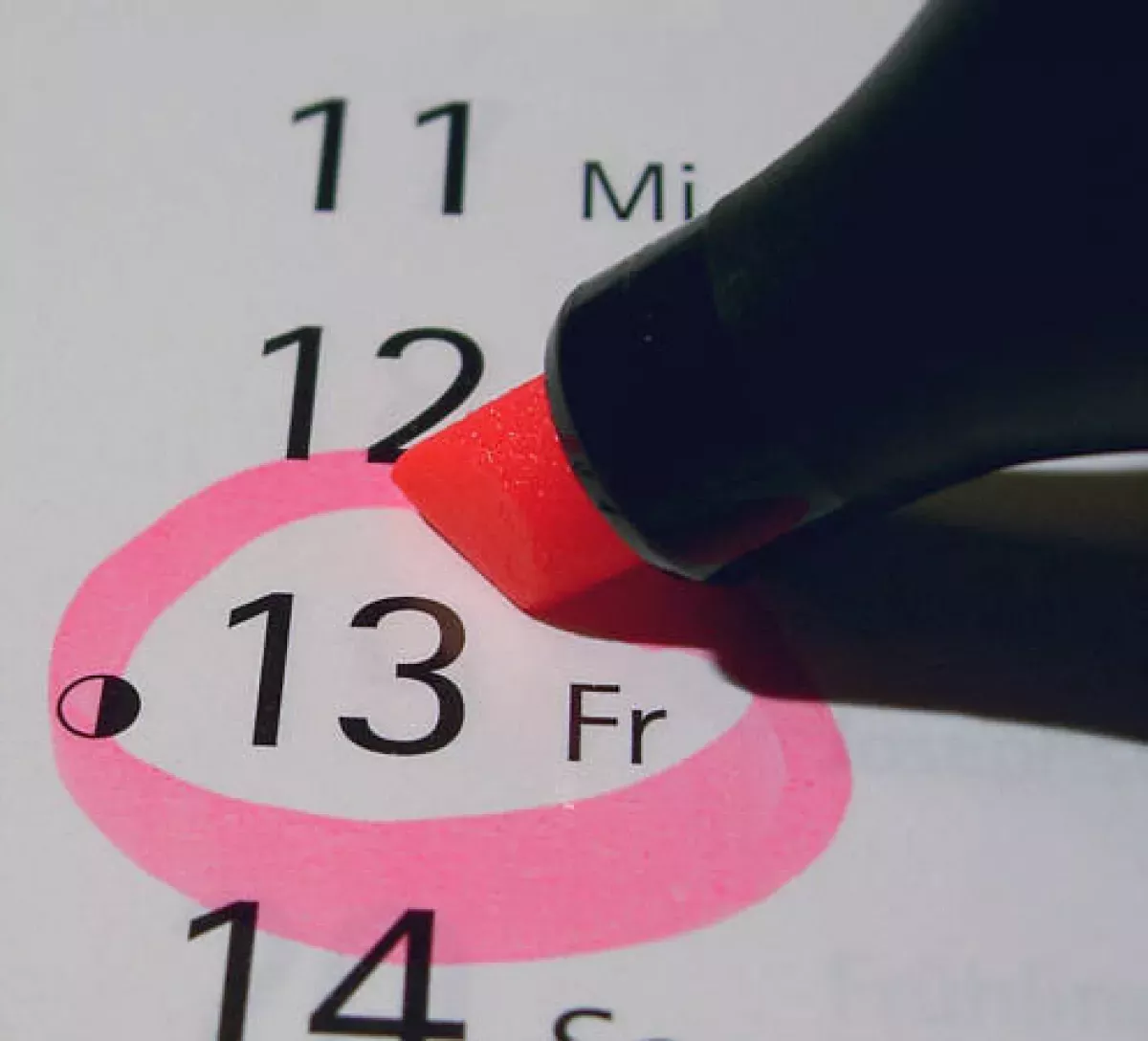Friday the 13th is a day considered unlucky in Western superstition, occurring when the 13th day of a month falls on a Friday. This happens at least once a year but can occur up to three times. Specific years, like common years starting on Thursday, have three Friday the 13ths in February, March, and November. Leap years beginning on Sunday also have three Friday the 13ths in January, April, and July. Other years have either two or just one Friday the 13th.
March 1900: 28-year cycle sequence starts in March 1900
The 28-year cycle for Friday the 13th occurrences began on 1 March 1900.
1907: Publication of "Friday, the Thirteenth" novel
In 1907, T. W. Lawson's novel "Friday, the Thirteenth" was published, potentially contributing to the popularization of the superstition. The novel features a broker exploiting the superstition to cause a Wall Street panic.
1984: Three Friday the 13ths in 1984
In 1984, a leap year starting on Sunday, there were three Friday the 13ths: in January, April, and July.
1993: Study on transport accidents on Friday the 13th
In 1993, a study by Scanlon, Luben, Scanlon, & Singleton suggested a possible increase in hospital admissions due to transport accidents on Friday the 13th, but the authors noted the small sample size and subsequent studies disproved any correlation.
1995: National Accident Day in Finland since 1995
Since 1995, Finland has observed National Accident Day (kansallinen tapaturmapäivä) on Friday the 13th, promoted by governmental and nongovernmental organizations and coordinated by the Finnish Red Cross to raise awareness about automotive safety.
1999: Longest period without a Friday the 13th: August 1999
The longest period without a Friday the 13th can be 14 months, such as from August 1999 to October 2000 in a leap year starting on Saturday.
2000: Release of "Shriek if You Know What I Did Last Friday the Thirteenth"
In 2000, the parody film "Shriek if You Know What I Did Last Friday the Thirteenth" was released in Italy as "Shriek – Hai impegni per venerdì 17?"
2000: Longest period without a Friday the 13th: October 2000
The longest period without a Friday the 13th can be 14 months, such as from August 1999 to October 2000 in a leap year starting on Saturday.
2001: Two Friday the 13ths in 2001
In 2001, there were two occurrences of Friday the 13th.
2002: Two Friday the 13ths in 2002
In 2002, there were two occurrences of Friday the 13th.
2003: One Friday the 13th in 2003
In 2003, there was one occurrence of Friday the 13th.
2004: Two Friday the 13ths in 2004
In 2004, there were two occurrences of Friday the 13th.
2005: One Friday the 13th in 2005
In 2005, there was one occurrence of Friday the 13th.
2006: Two Friday the 13ths in 2006
In 2006, there were two occurrences of Friday the 13th.
2007: Two Friday the 13ths in 2007
In 2007, there were two occurrences of Friday the 13th.
June 2008: Dutch Insurance Statistics on Accidents on Friday the 13th in June 2008
In June 2008, the Dutch Centre for Insurance Statistics reported that fewer accidents, fires, and thefts occur on Friday the 13th in the Netherlands, attributing it to increased caution or people staying home. They noted an average of 7,500 traffic accidents on Friday the 13th compared to the usual 7,800.
2008: One Friday the 13th in 2008
In 2008, there was one occurrence of Friday the 13th.
2009: Three Friday the 13ths in 2009
In 2009, a common year starting on Thursday, there were three Friday the 13ths: in February, March and November.
2009: Shortest period with a Friday the 13th: February-March 2009
The shortest period with a Friday the 13th is just one month, such as from February to March in the common year 2009 starting on Thursday.
2010: One Friday the 13th in 2010
In 2010, there was one occurrence of Friday the 13th.
2011: One Friday the 13th in 2011
In 2011, there was one occurrence of Friday the 13th.
2012: Three Friday the 13ths in 2012
In 2012, a leap year starting on Sunday, there were three Friday the 13ths: in January, April, and July.
2012: Longest period without a Friday the 13th: July 2012
The longest period without a Friday the 13th can be 14 months, such as from July 2012 to September 2013 in a common year starting on Tuesday.
2013: Two Friday the 13ths in 2013
In 2013, there were two occurrences of Friday the 13th.
2014: One Friday the 13th in 2014
In 2014, there was one occurrence of Friday the 13th.
2015: Three Friday the 13ths in 2015
In 2015, a common year starting on Thursday, there were three Friday the 13ths: in February, March and November.
2015: Shortest period with a Friday the 13th: February-March 2015
The shortest period with a Friday the 13th is just one month, such as from February to March in the common year 2015 starting on Thursday.
2016: One Friday the 13th in 2016
In 2016, there was one occurrence of Friday the 13th.
2017: Two Friday the 13ths in 2017
In 2017, there were two occurrences of Friday the 13th.
2018: Two Friday the 13ths in 2018
In 2018, there were two occurrences of Friday the 13th.
2018: Longest period without a Friday the 13th: July 2018
The longest period without a Friday the 13th can be 14 months, such as from July 2018 to September 2019 in a common year starting on Tuesday.
2019: Two Friday the 13ths in 2019
In 2019, there were two occurrences of Friday the 13th.
2020: Two Friday the 13ths in 2020
In 2020, there were two occurrences of Friday the 13th.
2021: One Friday the 13th in 2021
In 2021, there was one occurrence of Friday the 13th.
2022: One Friday the 13th in 2022
In 2022, there was one occurrence of Friday the 13th.
2023: Two Friday the 13ths in 2023
In 2023, there were two occurrences of Friday the 13th.
2024: Two Friday the 13ths in 2024
In 2024, there were two occurrences of Friday the 13th.
2025: One Friday the 13th in 2025
In 2025, there will be one occurrence of Friday the 13th.
2026: Three Friday the 13ths in 2026
In 2026, a common year starting on Thursday, there will be three Friday the 13ths: in February, March and November.
2026: Shortest period with a Friday the 13th: February-March 2026
The shortest period with a Friday the 13th is just one month, such as from February to March in the common year 2026 starting on Thursday.
2027: One Friday the 13th in 2027
In 2027, there will be one occurrence of Friday the 13th.
2027: Longest period without a Friday the 13th: August 2027
The longest period without a Friday the 13th can be 14 months, such as from August 2027 to October 2028 in a leap year starting on Saturday.
2028: One Friday the 13th in 2028
In 2028, there will be one occurrence of Friday the 13th.
2029: Two Friday the 13ths in 2029
In 2029, there will be two occurrences of Friday the 13th.
2029: Longest period without a Friday the 13th: July 2029
The longest period without a Friday the 13th can be 14 months, such as from July 2029 to September 2030 in a common year starting on Tuesday.
2040: Three Friday the 13ths in 2040
In 2040, a leap year starting on Sunday, there will be three Friday the 13ths: in January, April, and July.
2099: 28-year cycle sequence ends in 2099
The 28-year cycle for Friday the 13th occurrences ends on 28 February 2099.
Mentioned in this timeline
The Netherlands is a country located in Northwestern Europe and...
Italy officially the Italian Republic is located in Southern and...

Fire is a rapid oxidation process called combustion releasing heat...

September is the ninth month of the year in the...
Trending

1 month ago Harry Styles' Influence: Celebrity Boyfriend Phenomenon, Grammy Inspiration, and Album of the Year Debate.

6 months ago Margaret Cho Claims Ellen DeGeneres Mistreated Her for Years, Calling Her 'Mean'.
6 months ago Florian Wirtz Reportedly Transfers from Leverkusen to Liverpool for 140 Million Euros

7 months ago Declan Rice returns against Newcastle; Havertz nearing return from hamstring injury at Arsenal.

6 months ago Pulisic's Gold Cup Controversy: Donovan's Criticism and Pochettino's Stance on Game Selection

6 months ago Deontay Wilder returns to boxing against Tyrell Herndon, coached by Don House.
Popular

XXXTentacion born Jahseh Dwayne Ricardo Onfroy was a controversial yet...

Ben Shapiro is a prominent American conservative political commentator media...

Candace Owens is an American conservative political commentator and author...

Stranger Things created by the Duffer Brothers is a popular...
The Kennedy Center Honors are annual awards recognizing individuals and...

William Franklin Graham III commonly known as Franklin Graham is...
